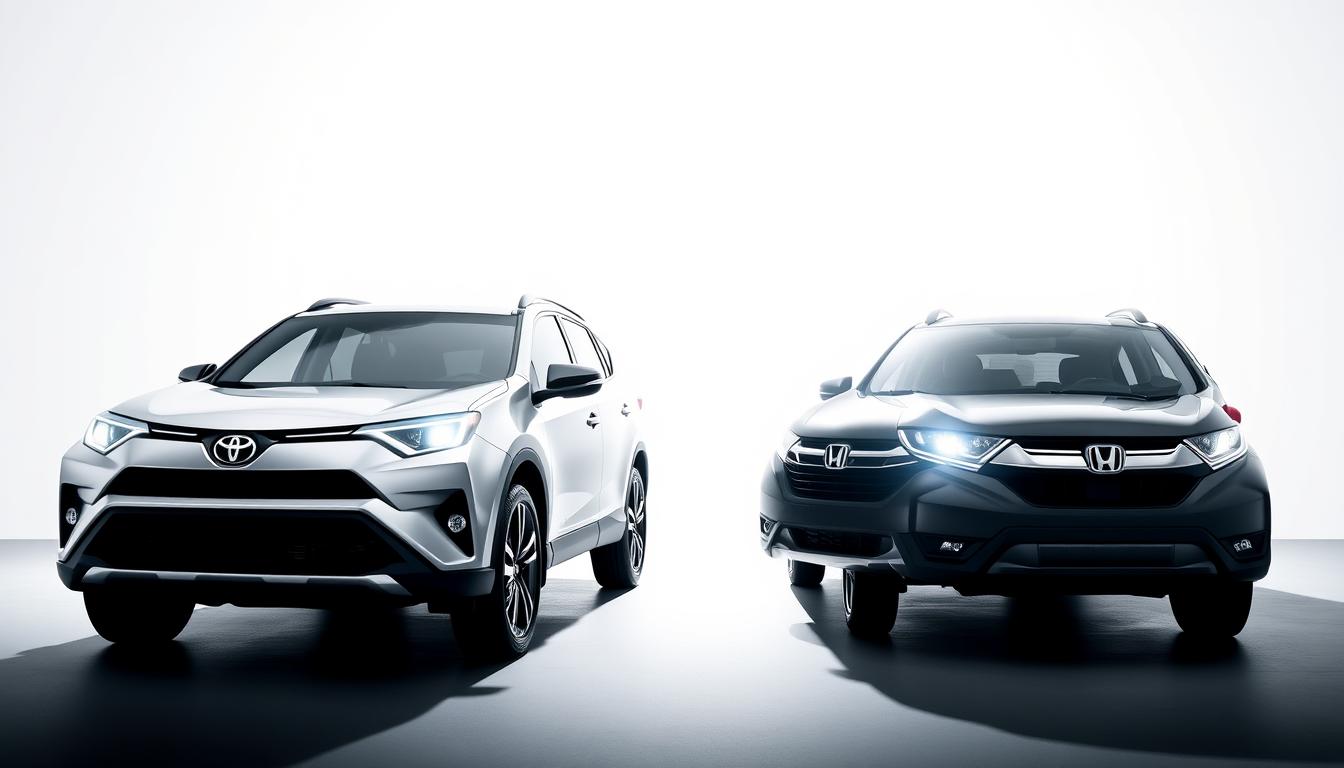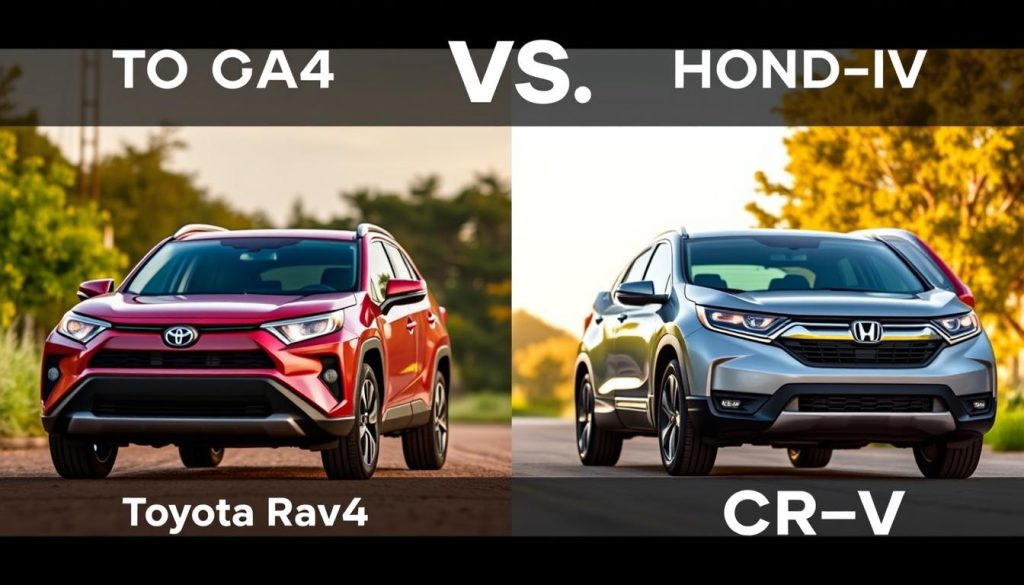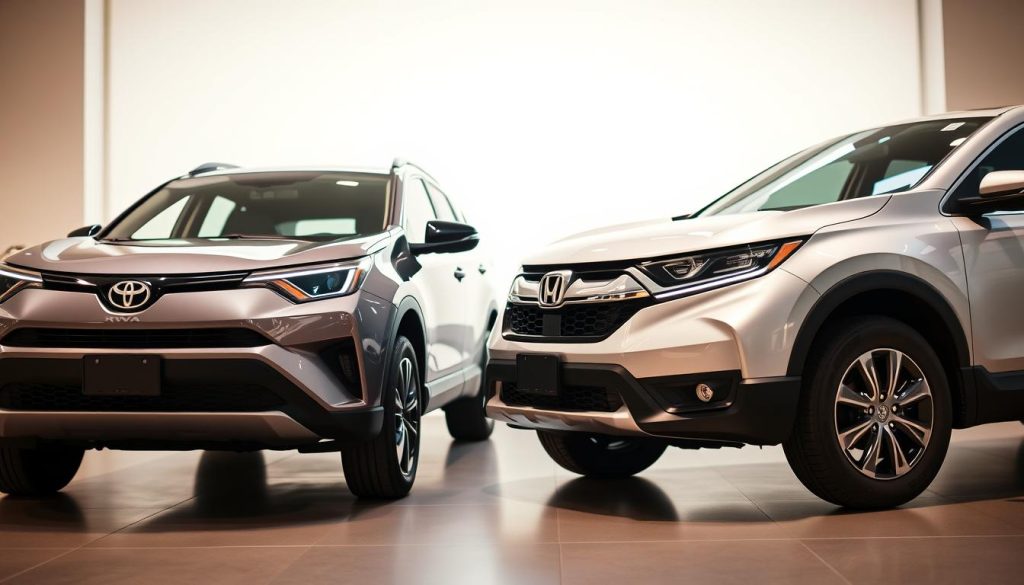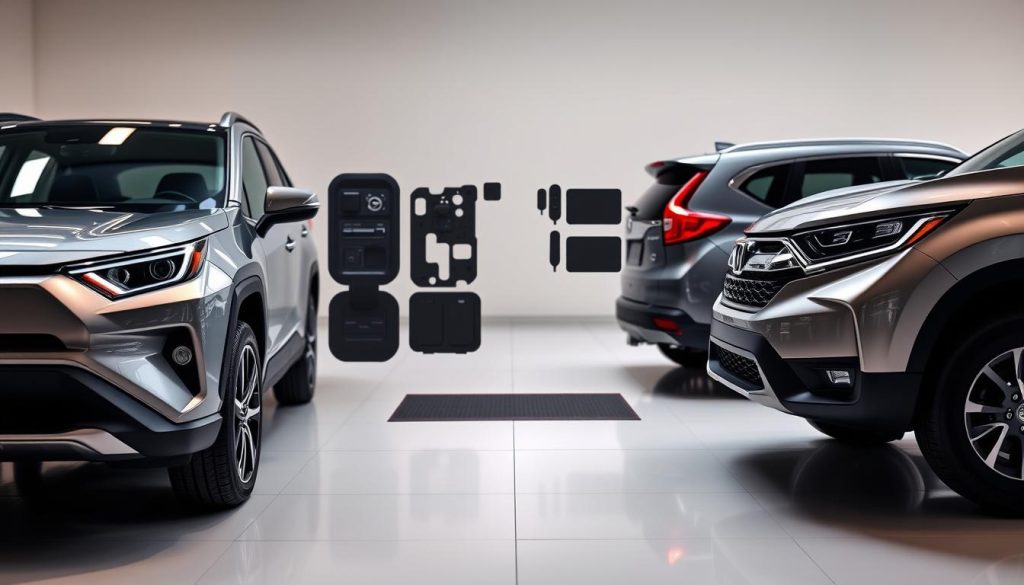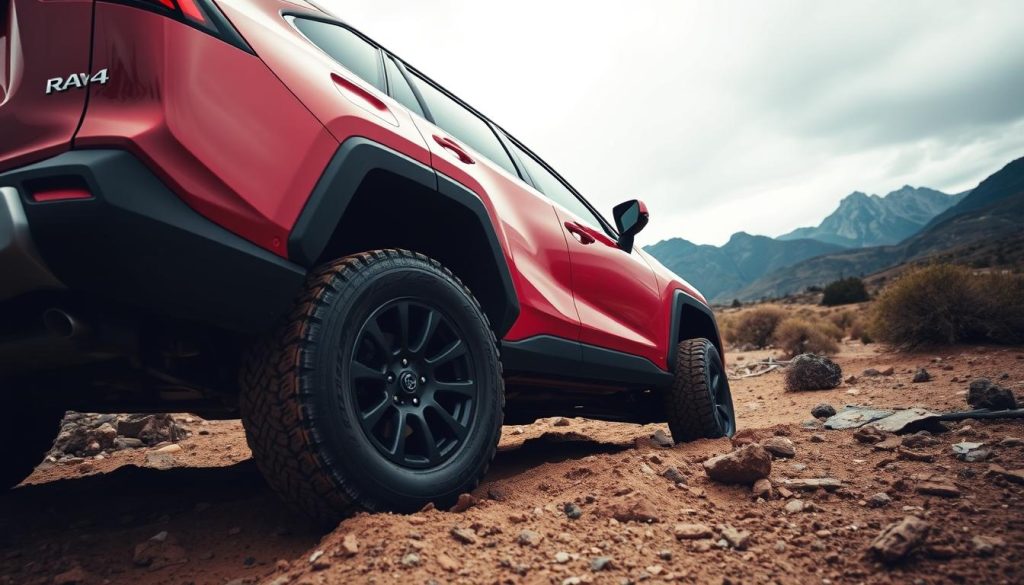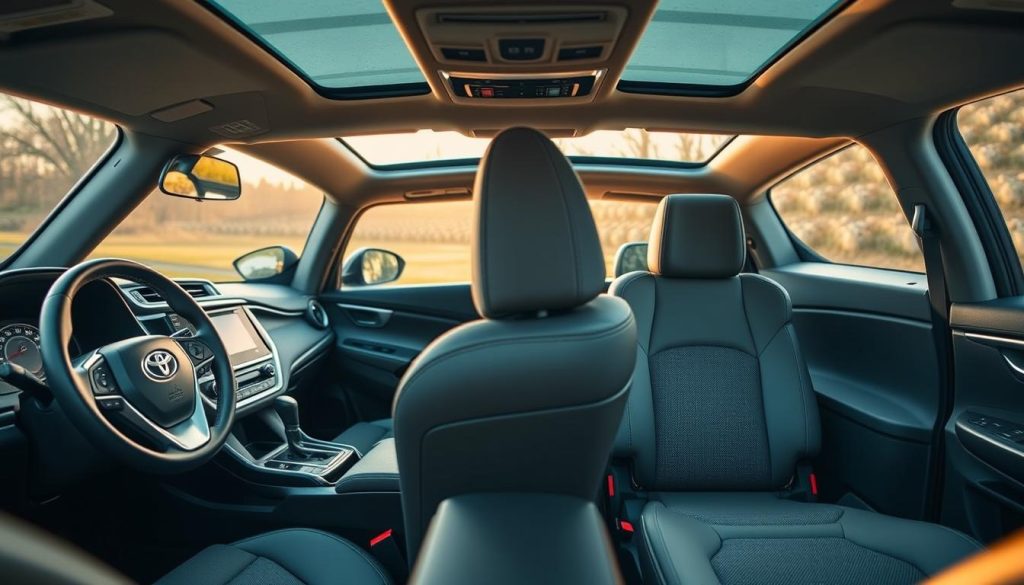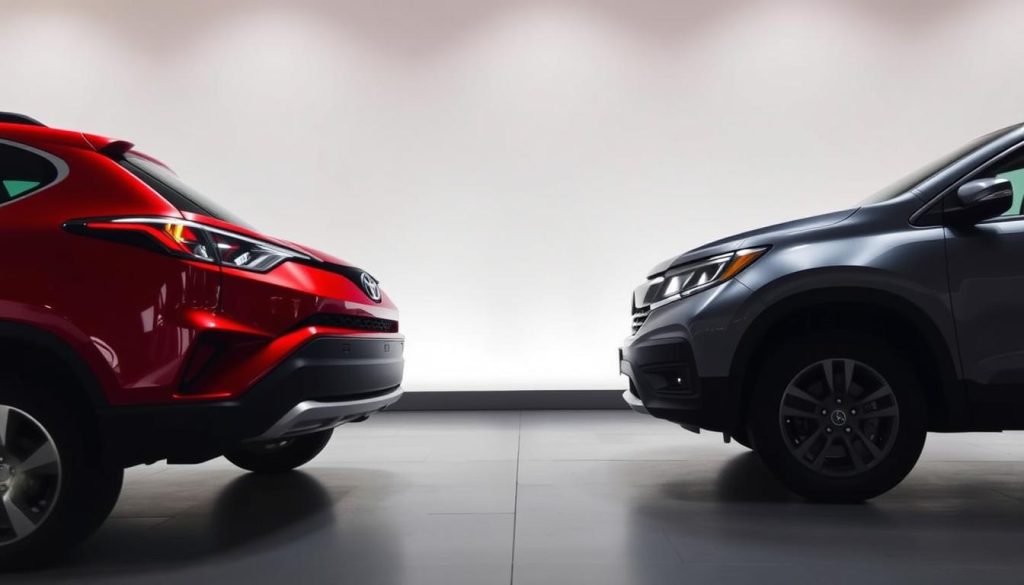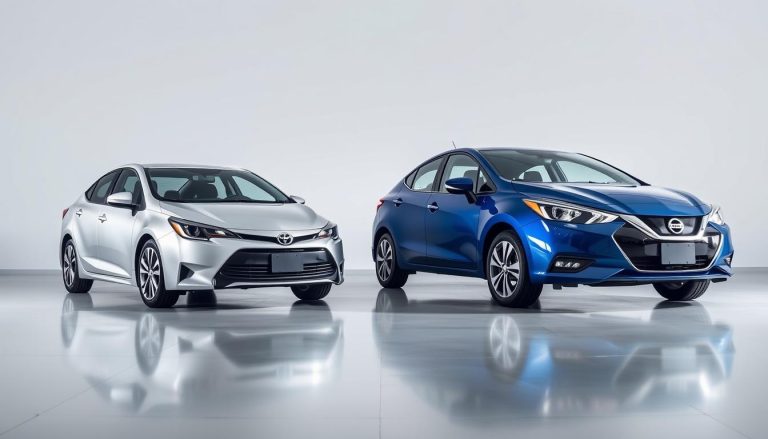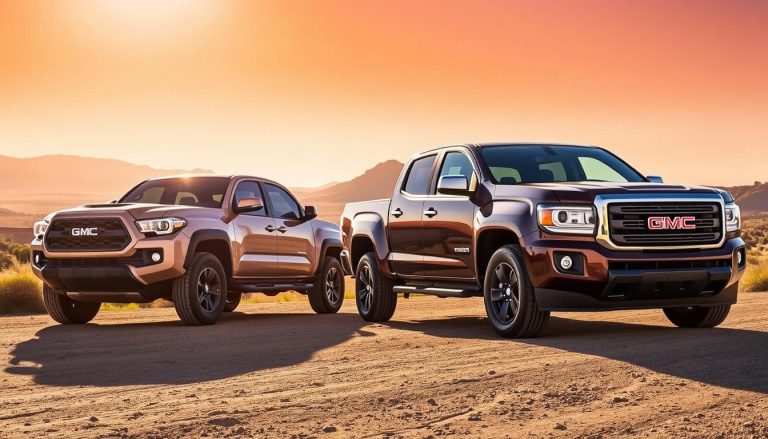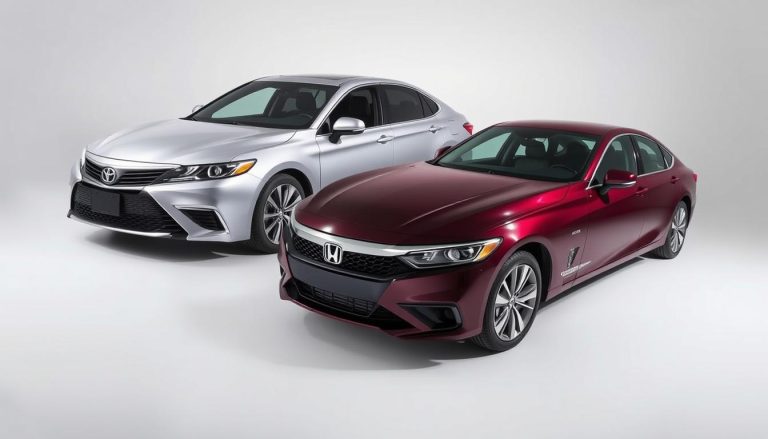Toyota RAV4 vs CR V: Which SUV is Right for You?
Choosing the right compact SUV can be tough. The Toyota RAV4 and Honda CR-V are among the best. They offer great reliability and performance.
When you compare the RAV4 and CR-V, you see two amazing SUVs. Each has its own strengths. This makes picking between them a bit harder.
People want SUVs that are practical, efficient, and fun to drive. The RAV4 and CR-V meet these needs well. They’re great for families, work, and adventures.
We’ll look at everything these SUVs offer. We’ll check their performance, design, tech, and how they do in real life. This will help you choose wisely.
Introduction to Compact SUV Market Leaders
The compact SUV market has changed a lot in the last ten years. Toyota RAV4 and Honda CR-V are now top choices for many drivers in the U.S. They are known for being reliable and versatile.
Looking at the RAV4 vs CR-V shows why they lead the market. They mix practicality, affordability, and performance well. This appeals to today’s drivers.
- Toyota RAV4 has been the top-selling compact SUV for five years
- Honda CR-V is known for its great fuel efficiency and roomy interior
- Both models are at the top of compact SUV engineering
“The compact SUV segment represents the sweet spot between sedan practicality and SUV versatility” – Automotive Trends Magazine
The RAV4 and CR-V have grown a lot, meeting new needs. They now have better fuel economy and safety features. This shows how the compact SUV market keeps getting better.
| Model | Annual Sales | Market Share |
|---|---|---|
| Toyota RAV4 | 430,387 | 5.7% |
| Honda CR-V | 361,271 | 4.8% |
As more people want cars that are good for city and suburban driving, the RAV4 vs CR-V debate is popular. It keeps drawing in car buyers all over the country.
RAV4 vs CR V: Core Differences
When we look at the Toyota RAV4 and Honda CR-V, we see two compact SUVs with their own unique traits. They show different ways to design, perform, and fit into the market.
Performance Specifications
The fight between the RAV4 and CR-V starts with their engines. Toyota has a strong 2.5-liter 4-cylinder engine. Honda, on the other hand, uses a 1.5-liter turbocharged 4-cylinder engine.
- Toyota RAV4: 2.5-liter naturally aspirated engine
- Honda CR-V: 1.5-liter turbocharged engine
- Both provide competitive power outputs
Design Philosophy
The Toyota RAV4 looks tough and ready for adventure. Its design shows it’s strong and capable. The Honda CR-V, on the other hand, is designed for city living. It has smooth lines and a calm look.
Market Positioning
The Toyota RAV4 is for those who love the outdoors and active families. It’s all about versatility. The Honda CR-V is for those who value comfort, efficiency, and easy city driving. Both SUVs aim for the same market but with different styles.
Each vehicle represents its manufacturer’s core values and target consumer preferences.
Looking at the RAV4 vs CR-V isn’t just about specs. It’s about finding the right car for your lifestyle.
Price Comparison and Value Proposition
Looking at the Toyota RAV4 and Honda CR-V, price is key for buyers. The 2025 models have a price landscape that needs careful thought.
Starting prices show a close race:
- Toyota RAV4: Begins at $28,850
- Honda CR-V: Starts at $30,100
The RAV4 vs CR-V pricing isn’t just about the base models. Each trim level has its own special offers. Buyers will see differences in standard features, tech packages, and build quality.
| Trim Level | RAV4 Price Range | CR-V Price Range |
|---|---|---|
| Base Model | $28,850 | $30,100 |
| Mid-Tier | $33,500 | $34,700 |
| Top Trim | $40,250 | $41,600 |
For those watching their budget, the RAV4 might be the better choice. It has lower starting prices across its trims. While the difference isn’t huge, it adds up when buying a car.
Don’t just look at the price. Think about the features, maintenance costs, and resale value too. These factors are important when comparing compact SUVs.
Engine Performance and Power Delivery
When we look at the Toyota RAV4 and Honda CR-V, we see interesting facts for car lovers. Both SUVs have strong engines that meet different driving needs.
Horsepower and Torque Breakdown
The Toyota RAV4 has a more powerful engine than the Honda CR-V. It makes 209 horsepower, while the CR-V makes 190. This difference affects how each car drives.
| Performance Metric | Toyota RAV4 | Honda CR-V |
|---|---|---|
| Horsepower | 209 hp | 190 hp |
| 0-60 mph Acceleration | 8.0 seconds | 8.2 seconds |
Transmission Options
The type of transmission affects how a car performs. The Toyota RAV4 has an 8-speed automatic. The Honda CR-V has a continuously variable transmission (CVT).
- Toyota RAV4: 8-speed automatic transmission
- Honda CR-V: Continuously variable transmission (CVT)
Acceleration and Response
Both SUVs have comparable acceleration. The RAV4’s extra horsepower gives it a slight edge in quickness.
Performance isn’t just about raw numbers, but how the vehicle feels during everyday driving experiences.
Drivers looking for a mix of power and efficiency will find these SUVs interesting. They offer unique driving experiences.
Interior Comfort and Space Configuration
When comparing compact SUVs, interior space is key. The Toyota RAV4 and Honda CR-V focus on comfort and function. They both aim to make your drive better.
Legroom is important for comfort. The CR-V has more room in the back, with 40.4 inches of rear legroom. This is 2.6 inches more than the RAV4’s 37.8 inches. More legroom means more comfort on long trips.
- RAV4 rear legroom: 37.8 inches
- CR-V rear legroom: 40.4 inches
- Difference: 2.6 inches in favor of CR-V
It’s not just about legroom. Both SUVs have well-designed cabins. They use ergonomic seats and quality materials. The seats are comfy, making both short and long drives pleasant.
| Feature | Toyota RAV4 | Honda CR-V |
|---|---|---|
| Front Headroom | 37.7 inches | 38.0 inches |
| Rear Headroom | 37.8 inches | 38.2 inches |
| Total Passenger Volume | 98.9 cubic feet | 102.9 cubic feet |
For those looking for a lot of space, the CR-V is a good choice. It has more room than the RAV4. This makes it perfect for those who value space.
Advanced Safety Features and Ratings
Safety is a top priority for SUV buyers looking at the RAV4 vs CR-V. Both Toyota and Honda have worked hard to create safety technologies. These protect drivers and passengers.
Today’s compact SUVs, like the RAV4 and CR-V, have advanced safety features. These features make driving safer and reduce risks. They are designed to prevent accidents and keep everyone safe.
Standard Safety Equipment
- Toyota Safety Sense 2.0 (RAV4)
- Honda Sensing Suite (CR-V)
- Pre-collision warning systems
- Lane departure alerts
- Dynamic radar cruise control
Crash Test Results
| Safety Rating Category | Toyota RAV4 | Honda CR-V |
|---|---|---|
| IIHS Overall Rating | Top Safety Pick+ | Top Safety Pick |
| NHTSA Overall Rating | 5-Star | 5-Star |
| Frontal Crash Test | Excellent | Excellent |
| Side Impact Protection | Superior | Superior |
Driver Assistance Systems
The RAV4 and CR-V have amazing driver assistance systems. Adaptive cruise control, lane keeping assist, and automatic emergency braking are key features. They make driving safer and more comfortable.
It’s important to try these systems during test drives. This way, you can see how they work and feel comfortable with them.
Fuel Economy and Efficiency Metrics
Fuel efficiency is key for today’s SUV buyers. The RAV4 and CR-V offer great fuel economy in both standard and hybrid models. This makes them stand out.
The Toyota RAV4 Hybrid and Honda CR-V Hybrid are very efficient. They help drivers save a lot on gas. Here are the main fuel efficiency numbers for these popular SUVs:
- RAV4 Hybrid: Up to 41 mpg city, 38 mpg highway
- CR-V Hybrid: Up to 43 mpg city, 36 mpg highway
Tests show both SUVs do well in city and highway driving. Fuel efficiency variations can affect how much you spend on gas over time. This is important for those watching their budget.
| Model | City MPG | Highway MPG | Combined MPG |
|---|---|---|---|
| RAV4 Hybrid | 41 | 38 | 40 |
| CR-V Hybrid | 43 | 36 | 40 |
When choosing a car, think about how you drive. Even though the numbers are similar, your driving habits will affect how much gas you use. This can save you money in the long run.
Cargo Space and Storage Solutions
When looking at compact SUVs like the Toyota RAV4 and Honda CR-V, cargo space is key. These cars offer smart storage solutions for different lifestyles. They’re great for daily drives and weekend trips.
Trunk Capacity Breakdown
In comparing these SUVs, we see small but important differences in cargo space. The Honda CR-V has a bit more room:
- CR-V: 39.3 cubic feet behind second row
- CR-V: 76.5 cubic feet with seats folded
- RAV4: 37.6 cubic feet behind second row
- RAV4: 69.8 cubic feet with seats folded
Flexible Storage Innovations
Both SUVs show smart design in their cargo areas. They have intelligent storage solutions to help drivers:
- Adjustable cargo floors
- Multiple tie-down points
- Hidden compartments
- Flat-folding rear seats
The difference in cargo space might seem small, but it’s big for active families and outdoor lovers.
When choosing between these SUVs, think about your storage needs. The small differences in cargo space can be big for your lifestyle.
Technology and Infotainment Systems
Modern SUV buyers want the latest tech. The Toyota RAV4 and Honda CR-V have top-notch infotainment systems. They offer features that make driving better.
The Toyota RAV4’s system is easy to use and has big screens. You can pick an 8-inch screen or go for a 10.5-inch one on higher trims. It also connects smoothly with Apple CarPlay and Android Auto.
The Honda CR-V has its own tech package. It has a touchscreen that changes size based on the trim. The system is designed to be easy to use and navigate.
- Toyota RAV4 Infotainment Highlights:
- 8-inch standard touchscreen
- 10.5-inch screen on premium trims
- Apple CarPlay and Android Auto
- Built-in navigation options
- Honda CR-V Infotainment Highlights:
- 7-inch base touchscreen
- 9-inch screen on higher trims
- Smartphone connectivity
- Advanced audio system
| Feature | Toyota RAV4 | Honda CR-V |
|---|---|---|
| Base Touchscreen Size | 8 inches | 7 inches |
| Premium Touchscreen Size | 10.5 inches | 9 inches |
| Smartphone Integration | Apple CarPlay/Android Auto | Smartphone Connectivity |
Both systems have wireless charging, USB ports, and voice recognition. The RAV4 and CR-V show that even compact SUVs can have great tech.
“Technology transforms the driving experience, making connectivity as important as performance.” – Automotive Technology Expert
Hybrid Model Comparison
The hybrid SUV market is getting more competitive. Toyota and Honda are leading with their eco-friendly options. The RAV4 Hybrid and CR-V Hybrid are two top choices for those who care about the environment.
Fuel Efficiency Breakdown
Both hybrids are great at saving fuel. The RAV4 Hybrid stands out with its top EPA-estimated rating. It offers:
- Excellent city and highway fuel economy
- Reduced carbon footprint
- Significant savings on fuel costs
Performance Differences
The RAV4 Hybrid gives a more exciting drive than the standard model. It has a strong hybrid powertrain that offers:
- Quicker acceleration
- Smoother power delivery
- Enhanced electric motor support
Price Premium Analysis
| Model | Base Price | Hybrid Premium | Estimated Fuel Savings |
|---|---|---|---|
| RAV4 Hybrid | $32,425 | $2,500 | $750/year |
| CR-V Hybrid | $31,650 | $2,200 | $650/year |
The RAV4 Prime plug-in hybrid is a top pick. It offers up to 42 miles of all-electric driving range. This makes it great for those who want to save fuel and reduce their environmental impact.
Reliability and Maintenance Costs
When looking at the Toyota RAV4 and Honda CR-V, reliability is key. These compact SUVs are known for being dependable. But, there are small differences to notice.
J.D. Power’s reliability ratings show some interesting points. The Honda CR-V usually scores better in long-term reliability. This means it performs well over many years. The Toyota RAV4 is close but has a bit more variation in reliability scores.
- Honda CR-V average annual maintenance costs: $407
- Toyota RAV4 average annual maintenance costs: $429
- Warranty coverage: 3-year/36,000-mile basic warranty for both models
Maintenance costs are also important for buyers. Routine service costs for both cars are pretty similar. The small differences won’t affect your long-term costs much.
Reliability isn’t just about avoiding breakdowns—it’s about consistent performance and peace of mind.
Here are some key things to think about when it comes to maintenance:
- Regular scheduled maintenance
- Availability of certified service centers
- Parts accessibility and cost
- Warranty comprehensiveness
Even though the CR-V has slightly better reliability, the RAV4 is a strong choice. Both cars offer reliable driving and reasonable maintenance costs.
Off-Road Capabilities and AWD Systems
Exploring the off-road features of the Toyota RAV4 and Honda CR-V shows some key differences. These differences can affect how well each SUV handles off-road adventures. Both SUVs have all-wheel-drive systems for different driving conditions. But, the RAV4 has more rugged options.
The Toyota RAV4 has impressive off-road features in its special trims:
- Adventure trim with enhanced ground clearance
- TRD Off-Road variant with advanced traction control
- Dynamic torque vectoring AWD system
The Honda CR-V takes a more cautious approach to off-roading. Its AWD system is good for light terrain and tough weather. But, it doesn’t have the off-road focused trims like the RAV4.
For those who love off-roading, the RAV4’s higher ground clearance and special drive modes are a big plus. The TRD Off-Road variant offers:
- Increased suspension travel
- Upgraded all-terrain tires
- Improved approach and departure angles
Key takeaway: While both SUVs offer capable AWD systems, the Toyota RAV4 provides more robust off-road options for adventurous drivers.
Interior Materials and Build Quality
When we look at compact SUVs like the Toyota RAV4 and Honda CR-V, we see more than just looks. The materials and build quality are key to lasting satisfaction and value.
Material Choices
The CR-V and RAV4 have different interior designs. Toyota’s RAV4 has a mix of textured and modern materials for a rugged yet refined feel. Honda’s CR-V goes for a smooth, premium look with soft surfaces.
- RAV4 interior features robust synthetic materials
- CR-V emphasizes soft-touch surfaces
- Both models use high-quality plastic and fabric combinations
Fit and Finish
Compact SUVs need to be precise in their interior quality. Both the RAV4 and CR-V show great attention to detail. They have minimal gaps and well-aligned parts.
| Criteria | Toyota RAV4 | Honda CR-V |
|---|---|---|
| Panel Alignment | Excellent | Superior |
| Button Responsiveness | Firm | Smooth |
| Material Consistency | Good | Very Good |
Durability Factors
In comparing compact SUVs, durability is key. Both the RAV4 and CR-V are built to last, with materials that resist wear and keep looking good over time.
- Stain-resistant fabric options
- Scratch-resistant surfaces
- Fade-resistant color treatments
Resale Value and Long-Term Ownership
When looking at the RAV4 vs CR-V, resale value is key. Both Toyota and Honda are known for keeping their value over time.
Kelley Blue Book says these SUVs hold their value well. The Toyota RAV4 usually beats the Honda CR-V in resale value.
- Toyota RAV4 average 5-year resale value: 54-58%
- Honda CR-V average 5-year resale value: 50-54%
“A vehicle’s resale value is as important as its initial purchase price.” – Automotive Experts
What affects resale value includes:
- Brand reliability reputation
- Maintenance costs
- Overall vehicle condition
- Market demand
| Factor | Toyota RAV4 | Honda CR-V |
|---|---|---|
| Average Depreciation Rate | 42-46% | 46-50% |
| Maintenance Cost (5 Years) | $3,500 | $4,200 |
| Reliability Rating | 4.5/5 | 4.3/5 |
When choosing between the RAV4 and CR-V, think about these resale value points.
Conclusion
The Toyota RAV4 and Honda CR-V are top picks in the compact SUV market. Each has its own strengths. They meet different needs and driving styles.
When comparing the RAV4 and CR-V, performance, safety, and tech are key. The RAV4 shines with its hybrid options and bold design. The CR-V, on the other hand, has a nicer interior and smoother ride. Think about what you need, like fuel efficiency or space, to choose the right SUV for you.
Both SUVs offer great value in the compact segment. The RAV4 is great for those who love adventure and hybrid tech. The CR-V is perfect for families wanting comfort and practicality. Try out both to see which fits your lifestyle best.
Choosing between the RAV4 and CR-V means finding the SUV that fits your life. Whether it’s the RAV4 or CR-V, you’re getting a reliable, top-notch SUV. It’s a smart choice for modern driving needs.
FAQ
What are the main differences between the Toyota RAV4 and Honda CR-V?
The Toyota RAV4 and Honda CR-V have different designs and features. The RAV4 is more rugged and better for off-road driving. On the other hand, the CR-V focuses on comfort and a smoother ride.
They also differ in engine power, interior design, and hybrid options.
Which SUV is more fuel-efficient?
Both SUVs are fuel-efficient, with hybrid models available. The Toyota RAV4 Hybrid usually gets better gas mileage. The RAV4 Prime plug-in hybrid has a long electric range.
But, the Honda CR-V Hybrid is also very fuel-efficient.
How do the safety features compare?
Both SUVs have top-notch safety features. Toyota’s Safety Sense and Honda Sensing offer similar systems. These include adaptive cruise control and automatic emergency braking.
Both models get high safety ratings from IIHS and NHTSA.
Which SUV offers more cargo space?
The Honda CR-V has a bit more cargo space. It offers 39.2 cubic feet behind the rear seats, expanding to 75.8 cubic feet. The RAV4 has 37.6 cubic feet, expanding to 69.8 cubic feet.
Both offer flexible storage solutions.
Are there significant differences in pricing?
Pricing is competitive, with both SUVs starting around the same price. The base models cost between ,000 and ,000. Hybrid models are a bit pricier, with the RAV4 Prime being the most expensive.
Which SUV is better for off-road driving?
The Toyota RAV4 is better for off-road driving, thanks to its Adventure and TRD Off-Road trims. These offer more ground clearance and robust AWD systems. The CR-V is good for light off-road use, but the RAV4 is more suited for rough terrain.
How do the hybrid models compare?
The RAV4 Prime has a plug-in hybrid, giving up to 42 miles of electric range. The CR-V Hybrid is fuel-efficient but doesn’t have a plug-in option. Both hybrids are better for the environment and fuel economy.
Which SUV has better reliability?
Toyota and Honda are both known for reliability. Toyota’s RAV4 often gets top marks from J.D. Power and Consumer Reports. But, the Honda CR-V is also very reliable, with low maintenance costs.
What are the key technology differences?
Both SUVs have modern infotainment systems with Apple CarPlay and Android Auto. The RAV4’s system is a bit easier to use. The CR-V’s system is clean and intuitive.
Both offer advanced tech features like wireless charging and premium audio systems.
Which SUV is best for families?
Both SUVs are great for families, with similar space and safety features. The Honda CR-V might be more comfortable inside. The Toyota RAV4 has more cargo options.
The choice depends on what your family needs most, like cargo space or off-road capability.

